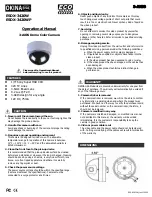
Configuring the Camera
AW00101510000
42
Basler IP Fixed Dome Cameras
3.5
Motion Detection Parameters
The parameters in the
Motion Detection
group are used to control the operation of the camera’s
motion detection function.
To understand what the parameters in this group do, you should have a basic idea about how
motion detection works:
Just before the camera captures a new image, it takes the last few captured images (from its
memory) and uses them to create an averaged image called a "history image".
Immediately after the camera captures a new image, it compares the pixels in the newly
captured image with the pixels in the history image. If enough pixels have changed, the camera
will determine that motion has been detected.
(When motion detection is enabled, this history image creation/comparison process occurs for
each image captured.)
Show Motion
- Enables or disables the show motion function.
Off
= Show motion function disabled.
On
= Show motion function enabled. The live image streams displayed in the web client will
show large blocks of green pixels in any areas where motion is detected.
Granularity
- Sets how many pixels in the current image will be compared to the history image.
1
means that every pixel will be compared,
2
means that every second pixel will be compared,
3
means that every third pixel will be compared, and so on.
Raising the granularity will speed-up the motion detection algorithm and reduce the load on the
microprocessor, but increasing it too much means that movement of small objects may be missed.
Sensitivity
- Sets the percentage of difference that must be present between a pixel in the current
image and the corresponding pixel in the history image for a change in the pixel to be detected.
1
means that the pixels must be 1 % different to detect a change,
2
means that they must be 2 %
different, and so on.
With this scheme, a higher setting means less sensitivity.
Motion Detection Mode
- Enables or disables motion detection.
Off
= Motion detection disabled.
On
= Motion detection enabled.
History Image Frames
- Sets the number of previously captured
images that will be used to create the history image. For example, if
this value is set to 3, the last 3 captured images will be used to create
the history image.
Higher values give better motion detection performance, but they
also slow down the speed of the motion detection algorithm and put
a greater load on the camera’s microprocessor.
















































